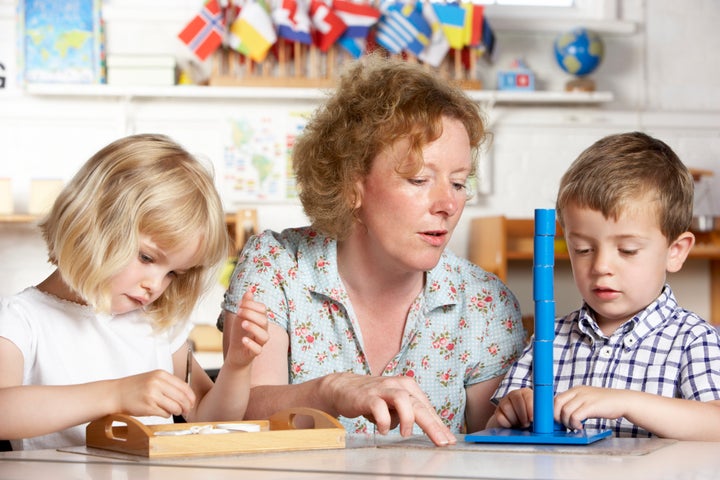
The gender gap in math may start at kindergarten ― and preschool teachers may unintentionally play some role in it.
A study published Thursday in AERA Open, a peer-reviewed journal of the American Educational Research Association, shows that’s where the disparity in performances between boys and girls begins.
Researchers tracked more than 5,000 kids who entered kindergarten in 1998 and another group of more than 7,500 preschoolers in 2010. They found the gender gap in mathematical abilities hasn’t changed much among kids who entered kindergarten 12 years apart.
At first, the girls and boys showed equal mathematical abilities. But then a gap started to develop and in the spring of kindergarten there were more boys than girls in the highest achieving group. By third grade, the gap was present across the board and was particularly strong among the highest achievers. This latter finding is especially disturbing, the researchers said.
“Future STEM-intending students are likely to be drawn from the high end of the achievement distribution, which is why it is so troubling that we see so few high-performing female students,” said Emily Miller, an assistant professor at the Department of Mathematics, West Chester University and a co-author of the study.
“Moreover, this same issue we observed in a national sample of students who began kindergarten in 2010 was largely unchanged from what we observed for students who began kindergarten over a decade prior in 1998.”
The disparities are persisting despite a lot of change in the educational landscape since 1998, such as the passing of the No Child Left Behind Act into law in 2001 and other similar initiatives, which should have increased attention to noticing and fixing any sort of gender gap.
Another striking finding of the study was that teachers may fuel the growth of the gap by having a different expectation from girls. New York University professor Joseph Robinson Cimpian said when he and his colleagues started to study the reason for the differences, they thought of examining the interplay between teachers’ biases against girls and the students’ real abilities. So they gathered a group of teachers to get their take. One of the teachers brought her test scores to prove them wrong.
“She kind of cut us off at the beginning and said ‘I don’t know why you guys are even studying this topic of gender gap in math. I brought my test scores here and you can see that the girls are performing just as well as the boys,’” recalled the associate professor of economics and education policy.
Then the teacher told them, “‘That’s because girls can perform as well as boys if they try hard enough.”
Cimpian said these comments shocked the researchers. “And suddenly she had this aha moment: ‘Oh my goodness! I did exactly what you are saying teachers are doing. OK, never mind, I take that back,’” he added.
Indeed, their study shows that teachers consistently rate girls as lower achieving than boys even if those girls and boys have identical achievement scores (that teachers aren’t aware of) on Department of Education tests.
In other words, the team found evidence of implicit bias from teachers, which could sway girls away from pursuing math related fields in the future.
“We really need to think about our training of our teachers and making them aware of their potential implicit biases.”
- Joseph Robinson Cimpian, associate professor of economics and education policy
This bias can be purely unintentional and implicit. The teachers’ ratings of students is gathered in a way that they never compare girls and boys. Instead, they rate the students on very specific abilities, such as how proficient a child is in using manipulative to add and subtract two-digit items.
The finding of a bias against female students reflects the cultural attitudes in society at large, something which has contributed to underrepresentation of women in STEM fields.
Still, teachers of early grade may be singularly important in shaping children’s future trajectory.
“The teachers have an outsized effect on future generations because of the concentrated amount of time they spend with them,” Cimpian said.
Teachers’ lower expectations of girls can influence their future abilities in several ways. Research going back to at least the 1960s shows that people rise to the expectations and perform better if they are simply expected to. The opposite happens faced with lower expectations.
Moreover, when female teachers have math anxiety themselves, they may send the wrong signals to girls, a 2009 study by University of Chicago professor Sian Beilock shows. “Teachers who are more math phobic in first grade would transmit that math phobia to their female students,” Cimpian said. It could be that girls are better at picking up that anxiety or they may see the female teacher as their role model.”
Reducing this bias could have significant consequences. Cimpian’s earlier work has suggested that if teachers didn’t think girls were less capable then the gender gap would develop only half as much.
“We really need to think about our training of our teachers and making them aware of their potential implicit biases,” he said. “We really need to focus on pre-service education for teachers and also in-service education.”
Study co-author Sarah Lubienski, a professor at the University of Illinois at Urbana-Champaign, said teachers could encourage girls in their development of bold problem solving and spatial skills in order to reduce bias. “For example, teachers should praise girls for inventing new strategies to solve problems, as opposed to praising conventional methods, correct answers, and neatness,” she said.
Parents are also influential on children, of course. And they may be able to take steps to counteract implicit biases against girls.
“Girls should not hear their mothers say ‘I was never any good at math,’” Lubiensky said. “Moms should model mathematical confidence and curiosity around their daughters. Additionally, Parents should expose girls to books and games that involve mathematical patterns, praising girls for trying new problem solving strategies.”
